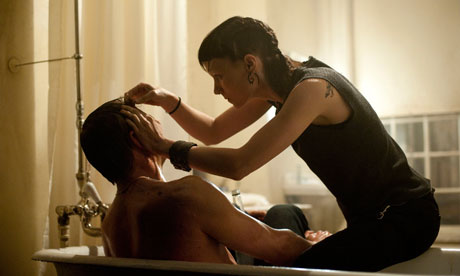The Girl With the Dragon Tattoo – review
Newcomer Rooney Mara makes a superb Lisbeth Salander in David Fincher's faithful remake of the gritty Swedish crime thriller

Daniel Craig and Rooney Mara in The Girl With the Dragon Tattoo.
In 1936 the Hollywood mogul David O Selznick bought the Swedish movie Intermezzo, signed up its star Ingrid Bergman and remade it in 1939 under the same title with Bergman repeating her original role in an otherwise British and American cast. During pre-production he sent a three-page memo to his chief producer about such adaptations. "I want to impress on you strongly," he wrote, "that the most important saving to be effected in remaking foreign pictures – a saving that more than offsets the doubtful foreign markets that have been used up by the original version, and that makes these remakes uniquely desirable – is in the shooting, by actually duplicating, as far as possible, the [earlier] film." And he added: "Granted a good cast, direction as good as Molander's on the original, a somewhat faster tempo than his, for I think the pace is much too slow for an Anglo-Saxon audience, and some cuts – we can duplicate the picture."
- The Girl With the Dragon Tattoo (US)
- Production year: 2011
- Countries: Rest of the world, USA
- Cert (UK): 18
- Runtime: 152 mins
- Directors: David Fincher, Niels Arden Oplev
- Cast: Christopher Plummer, Daniel Craig, Joely Richardson, Lena Endre, Michael Nyqvist, Noomi Rapace, Peter Haber, Robin Wright, Rooney Mara, Stellan Skarsgard, Steven Berkoff, Sven-Bertil Taube, Yorick van Wageningen
The producer Scott Rudin could have sent a near identical memo to Steven Zaillian and David Fincher, respectively the screenwriter and director of this swift remake of another Swedish movie, the political thriller The Girl With the Dragon Tattoo, a version of the first novel in Stieg Larsson's bestselling Millennium trilogy. In the original film, directed by the Danish film-maker Niels Arden Oplev, an investigative journalist from a leftwing magazine, Mikael Blomkvist, is hired by a wealthy retired business tycoon, once head of a major family-owned conglomerate, to find out what happened to a much loved grand-niece who suddenly disappeared as a teenager 40 years earlier. As his search becomes increasingly complex, Blomkvist engages an assistant, the fiery bi-sexual punk goth Lisbeth Salander, a brilliant computer hacker who's been made a ward of the state due to her violent, antisocial activities. Together they uncover a series of grisly killings at the black heart of their elderly client's family.
The temptation to transpose this story to the dark California of Raymond Chandler and Ross Macdonald must have been considerable, especially as Fincher, one of the most gifted directors at work today, has made two remarkable serial-killer movies, the futuristic Se7en and the semi-documentary Zodiac based on an actual series of Californian murders. But instead Rudin, Zaillian and Fincher have more or less followed Selznick's advice, though less as a means of saving money than of recognising that the movie's strength comes from the Scandinavian setting.
A certain tradition of books, plays and films dealing with corrupt, family-dominated business empires stretches from Hamlet through the plays of Ibsen and the financial scandals of the pre-war Swedish tycoon Ivar Krüger up to such recent Danish films as Festen and Melancholia. And of course Larsson's novels, which are partly inspired by the rich, secretive Swedish dynasties that made a suave accommodation with the Social Democrats and the trade unions, exploited the nation's neutrality during the second world war and have cupboards stacked with skeletons. This is essential to the film's dramatic fibre and political tensions and is embodied in Blomkvist and Salander.
The film has been shot on well-chosen locations in rainy Stockholm and the frozen north, and a major, and wise, decision was to have the characters speak an informal, rather neutral English with a slight Swedish inflection. The only Swedish actor with a major role (he plays the CEO of the family business) is that ubiquitous figure in contemporary cinema Stellan Skarsgård. Daniel Craig is suitably rumpled as the idealistic Blomkvist and Rooney Mara is sensationally good as Salander, one of the most remarkable creations in recent crime fiction. The actors who created these roles, Michael Nyqvist and Noomi Rapace, are not well served in blockbusters that opened this past month, Mission: Impossible – Ghost Protocol and Sherlock Holmes: A Game of Shadows.
Ultimately, this brisk, intelligent thriller lacks social and political commitment. Fincher is not passionately engaged by the Swedish scene, and I feel that had he re-created Larsson's book in California it might have achieved an illuminating anger that matched Ivan Passer's Cutter's Way, a film with significant parallels with The Girl With the Dragon Tattoo. No one could fail to enjoy this movie, but it's the product of an art and an industry that went in different directions with the coming of sound, and popular English-speaking audiences never became accustomed to reading subtitles.



Nenhum comentário:
Postar um comentário